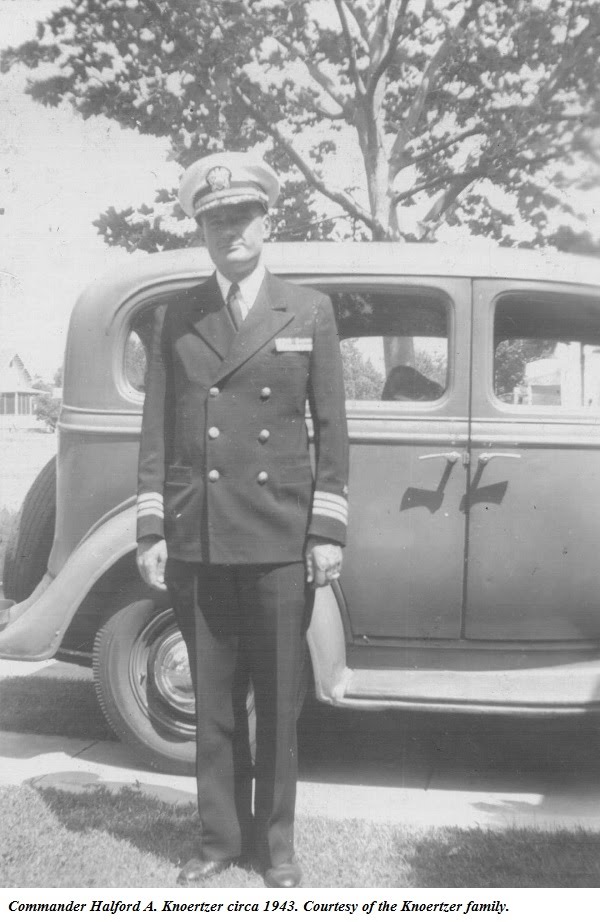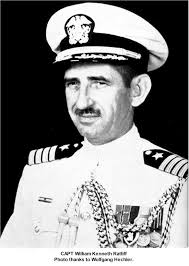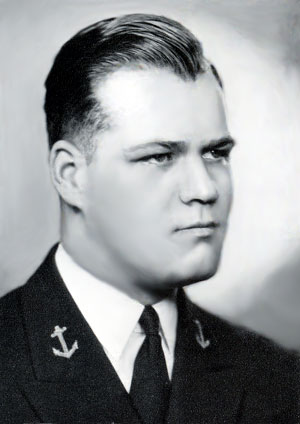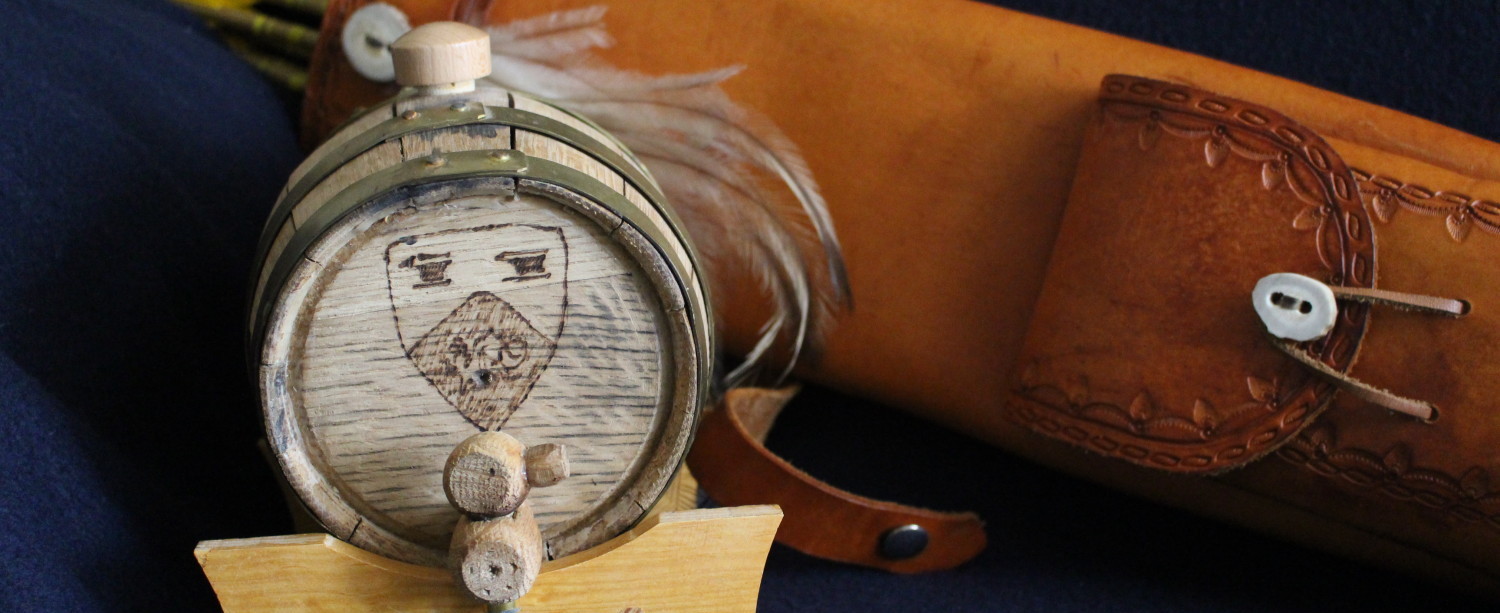“Lords” of the Ring – Pre-Pearl Harbor
(Updated 7/26/2019)
In my original post on this topic “Lords” of the Ring, I outlined my search for the answer to a question regarding a napkin ring that my Father-in-Law used. The ring was inscribed with his WWII ship commissioning date, its hull number and the position, “First Lieutenant.” Beneath the engraving, there are 8 names. The names fit  very nicely with the order in which the officers either arrived on the Patterson and/or when they assumed the position of “First Lieutenant.” At the urging of a ship museum curator, I decided to do some research on these 8 men. As I mentioned in my previous post, many of these individuals had stellar Navy careers and other interesting life experiences. Here is a little bit about each one of those people who served pre-Pearl Harbor on the USS Patterson. (Updated this post on 5/24/2019 with link to picture of Patterson damage described below).
very nicely with the order in which the officers either arrived on the Patterson and/or when they assumed the position of “First Lieutenant.” At the urging of a ship museum curator, I decided to do some research on these 8 men. As I mentioned in my previous post, many of these individuals had stellar Navy careers and other interesting life experiences. Here is a little bit about each one of those people who served pre-Pearl Harbor on the USS Patterson. (Updated this post on 5/24/2019 with link to picture of Patterson damage described below).
Halford A. Knoertzer
“Hal” Knoertzer was born in 1911 and graduated from the U.S. Naval Academy in 1932. Before serving on the Patterson, he served on USS Colorado (BB-45), the USS Oglala (CM-4), and USS Saratoga (CV-3). In January of 1937, as a Lt(jg)., he transferred to the Patterson for fitting out and commissioning (September 22, 1937). He left the Patterson on June 23, 1938 for the Naval Academy after a promotion to Lt. In June of 1940, he transferred to the USS Upshur (DD-144), then in April of 1943 he assumed command of the USS McCalla (DD-488).
This set up an unlikely encounter with his old ship, the Patterson. On September 29, 1943 just bef ore midnight, the McCalla, was engaged with Japanese barges north of Kolombangara Island (Solomon Islands). After several engagements with the barges, McCalla dodged a number of projectiles that landed close to the ship. Due to the engagements, McCalla was some distance from the main task group and was ordered to join up with the rest of the ships. At some point on her return to the task group, she experienced a steering casualty and when some of the smoke of the battle cleared it was evident that she was on a collision course with Knoertzer’s old ship, the Patterson. The Patterson attempted to avoid the collision but was struck by McCalla‘s bow just forward of the #1 gun turret. The bows of both ships were sheared off. The Patterson suffered 3 men killed and more than a dozen wounded in the collision (see photo of Patterson damage). The McCalla fared much better with only one injury. Clearly, this was not the way that Knoertzer wanted to have a reunion with his old ship. Both ships were outfitted with temporary bows and headed to dry dock for more intensive repair.
ore midnight, the McCalla, was engaged with Japanese barges north of Kolombangara Island (Solomon Islands). After several engagements with the barges, McCalla dodged a number of projectiles that landed close to the ship. Due to the engagements, McCalla was some distance from the main task group and was ordered to join up with the rest of the ships. At some point on her return to the task group, she experienced a steering casualty and when some of the smoke of the battle cleared it was evident that she was on a collision course with Knoertzer’s old ship, the Patterson. The Patterson attempted to avoid the collision but was struck by McCalla‘s bow just forward of the #1 gun turret. The bows of both ships were sheared off. The Patterson suffered 3 men killed and more than a dozen wounded in the collision (see photo of Patterson damage). The McCalla fared much better with only one injury. Clearly, this was not the way that Knoertzer wanted to have a reunion with his old ship. Both ships were outfitted with temporary bows and headed to dry dock for more intensive repair.
 Knoertzer went on to command the USS Hunt (DD-674), the USS Henderson (DD-785) during WWII, and the USS Montague (AKA-98) during the Korean War.
Knoertzer went on to command the USS Hunt (DD-674), the USS Henderson (DD-785) during WWII, and the USS Montague (AKA-98) during the Korean War.
His already distinguished career was further enhanced by the fact that he won two Silver Star Medals. Here is the citation for the first one:
Awarded for actions during the World War II
The President of the United States of America takes pleasure in presenting the Silver Star to Commander Halford A. Knoertzer (NSN: 0-71356), United States Navy, for conspicuous gallantry and intrepidity in action while in Command of a United States Destroyer, participating in the capture and occupation of Saipan, the First Battle of the Philippine Sea, 19 – 20 June 1944; the capture and occupation of Guam, the following raids: Palau-Yap-Ulithi 25 – 27 July 1944, Mindanao and Visayas 9 – 14 September 1944, Luzon 21 – 23 September 1944, Nansei Shoto and Formosa 6 – 14 October 1944, support raids against enemy installations in the Philippines 20 October to 27 November 1944, and the Second Battle of the Philippine Sea 24 – 25 October 1944. His ship maintained an outstanding record for providing gunfire protection for our heavy units against enemy air attacks particularly on 12, 13, and 14 October 1944, and for the rescue of twenty-two downed air crews. His courage and intrepidity in action was an inspiration to his men and were at all times in keeping with the highest traditions of the United States Naval Service.
General Orders: Commander 2d Carrier Task Force Pacific: Serial 0995 (January 17, 1945)
Action Date: June 19 – 20, July 25 – 27, & September 1944
I have been unable to find the specific citation for the second Silver Star Award.
Knoertzer retired from the Navy in 1960 with 28 years service at the rank of Captain. He passed away in 1986.
William K. Ratliff
William entered the service in 1934 and graduated from the U.S. Naval Academy in 1938. In his early years he served aboard the USS Pennsylvania (BB-38) before reporting for duty on the Patterson. He was on the Patterson during the Pearl Harbor attack; the only one of the first 4 men on the napkin ring who came on board before Pearl Harbor and was still on board in December 1941.
Ratliff left the Patterson on February 5, 1 942, for service on the USS Laffey (DD-459). During the Battle of Guadalcanal, November 13, 1942, the Laffey got into a firefight at point-blank range with several Japanese vessels including the battleship Hiei. The Laffey was hit by a 14in shell and a torpedo in the fantail. She exploded and sank quickly. Lt. Ratliff was wounded and evacuated for treatment. After recovery, Ratliff, now a Lt.Cdr, commanded the USS Swanson (DD-443) and then the USS Bache (DD-470). During the Korean War, Ratliff commanded the USS John W. Thomason (DD-760). After that, he held various command positions and retired at the rank of Captain.
942, for service on the USS Laffey (DD-459). During the Battle of Guadalcanal, November 13, 1942, the Laffey got into a firefight at point-blank range with several Japanese vessels including the battleship Hiei. The Laffey was hit by a 14in shell and a torpedo in the fantail. She exploded and sank quickly. Lt. Ratliff was wounded and evacuated for treatment. After recovery, Ratliff, now a Lt.Cdr, commanded the USS Swanson (DD-443) and then the USS Bache (DD-470). During the Korean War, Ratliff commanded the USS John W. Thomason (DD-760). After that, he held various command positions and retired at the rank of Captain.
Ratliff was cited numerous times for his valor and service. He earned 4 Bronze Star medals, three of which had the “V” device attached. He died in 2004 at the age of 88.
Jack H. Brandt (AKA John Henry Brandt)
Jack Brandt, whose actual name was John Henry Brandt was born in Washington state. Brandt was a graduate of the U.S. Naval Academy in the class on 1935. According to the Annapolis yearbook “Lucky Bag”, he was sometimes called  “Bugs” and had won a gold medal for prowess with small weapons. He was a Plankholder at the rank of Ensign on the USS Patterson when commissioned in 1937. I have been unable to pinpoint the exact time of his departure from the Patterson, but by early 1943 he was on the USS Chicago (CA-29) at the rank of Lt. On January 30, 1943, the Chicago came under heavy aircraft attack with torpedoes. Two hits damaged her severely and she was put in tow by the USS Louisville (CL/CA- 28) and then the USS Navajo (AT-64). The next afternoon, she sustained 4 more torpedo hits that sank her. As a result of his actions during the sinking of the Chicago, Brandt was awarded the Silver Star for valor. Here is the citation:
“Bugs” and had won a gold medal for prowess with small weapons. He was a Plankholder at the rank of Ensign on the USS Patterson when commissioned in 1937. I have been unable to pinpoint the exact time of his departure from the Patterson, but by early 1943 he was on the USS Chicago (CA-29) at the rank of Lt. On January 30, 1943, the Chicago came under heavy aircraft attack with torpedoes. Two hits damaged her severely and she was put in tow by the USS Louisville (CL/CA- 28) and then the USS Navajo (AT-64). The next afternoon, she sustained 4 more torpedo hits that sank her. As a result of his actions during the sinking of the Chicago, Brandt was awarded the Silver Star for valor. Here is the citation:
The President of the United States of America takes pleasure in presenting the Silver Star to Lieutenant John Henry Brandt (NSN: 0-74826), United States Navy, for conspicuous gallantry and intrepidity in action during an engagement with Japanese aircraft off Rennell Islands while serving on board the U.S.S. CHICAGO (CA-29) on 30 January 1943. Despite personal injuries to his side and back, including three broken ribs, received in an engagement the previous evening, Lieutenant Brandt gave valuable assistance in supervising the launching of floater nets and life rafts and in directing personnel overboard when the ship was abandoned and removed his life jacket and gave it to an injured man who had none, thereby necessitating that he enter the water in an injured condition and without a life jacket. His actions were in keeping with the highest traditions of the United States Naval Service.
General Orders: Commander South Pacific: Serial 00431 (February 22, 1943)Action Date: January 30, 1943
Brandt commanded the USS Floyd B. Parks (DD-884) from May 10, 1946 – Oct 3, 1947 and the USS Compass Island (E-AG-153) from December 1958 – October 1959.
John Henry Brandt eventually retired from the Navy at the rank of Captain. He died in 1975.
Greer Assheton Duncan, Jr.
Greer Duncan graduated from the U.S. Naval Academy in 1937. His father was also a graduate of Annapolis. He came aboard the Patterson sometime in 1938 and was already off of the Patterson by July, 1939 when he joined the crew of the USS Marblehead (CL-12). In Late 1939, Duncan was ordered to submarine school in New London and in November of 1940 he was aboard the submarine USS Bonita (SS-165). In 1942, he became the XO of the Bonita and in October of 1942, he arrived for duty on the USS Sunfish (SS-281). From August of 1943 until October of 1943, Duncan served as Captain of the USS S-23 (SS-128) and then became the XO of the USS Tullibee (SS-284) in December of 1943. On her 4th war patrol, the Tullibee launched two torpedoes from her bow tubes at a ship in a convoy. About two minutes after launching the torpedoes, the Tullibee experienced a violent explosion and sank. There was only one survivor. After the war, it was determined that the Tullibee had been struck by her own torpedo that had run a circular course. Lt.Cdr. Duncan was awarded the Purple Heart medal posthumously.
also a graduate of Annapolis. He came aboard the Patterson sometime in 1938 and was already off of the Patterson by July, 1939 when he joined the crew of the USS Marblehead (CL-12). In Late 1939, Duncan was ordered to submarine school in New London and in November of 1940 he was aboard the submarine USS Bonita (SS-165). In 1942, he became the XO of the Bonita and in October of 1942, he arrived for duty on the USS Sunfish (SS-281). From August of 1943 until October of 1943, Duncan served as Captain of the USS S-23 (SS-128) and then became the XO of the USS Tullibee (SS-284) in December of 1943. On her 4th war patrol, the Tullibee launched two torpedoes from her bow tubes at a ship in a convoy. About two minutes after launching the torpedoes, the Tullibee experienced a violent explosion and sank. There was only one survivor. After the war, it was determined that the Tullibee had been struck by her own torpedo that had run a circular course. Lt.Cdr. Duncan was awarded the Purple Heart medal posthumously.
In my next post, I will highlight the other 4 officers listed on the ring. All but one of them came on board after Pearl Harbor.
Link to “Lords” of the Ring – Post Pearl Harbor.
UPDATE: The Ring Has A New Home.

wonderful work here! John Henry Brandt is my 2nd great uncle! I have pictures of him if you’d like them 🙂
Greetings, Abigail!
I would love to post Mr. Brandt’s pictures, with credit to you. Your great uncle’s bravery at the Battle of Rennell Island was inspiring: A true hero! Pictures can be emailed to me at socpsy at gmail dot com. Thank you so much!
Dave
I realized that I had not linked Mr. Brandt’s picture from Annapolis’ Lucky Bag. I added it this morning. I also linked to his Lucky Bag text entry, which can be seen by clicking on the link mentioning his nickname, Bugs.